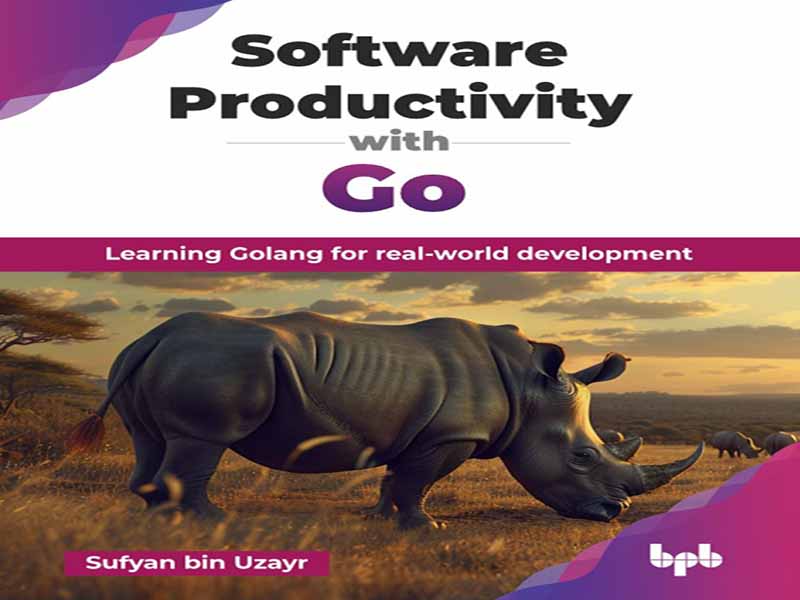- عنوان کتاب: Software Productivity with Go -Learning Golang for real-world development
- نویسنده: Sufyan bin Uzayr
- حوزه: برنامه نویسی Go
- سال انتشار: 2025
- تعداد صفحه: 548
- زبان اصلی: انگلیسی
- نوع فایل: pdf
- حجم فایل: 3.59 مگابایت
زبان برنامهنویسی Go یا Golang، همانطور که اغلب نامیده میشود، به عنوان یکی از قدرتمندترین زبانهای برنامهنویسی در توسعه نرمافزار مدرن ظهور کرده است. Go که با در نظر گرفتن سادگی، کارایی و مقیاسپذیری طراحی شده است، ابزارهایی را برای توسعهدهندگان فراهم میکند تا به شیوهای ساده با چالشهای پیچیده مقابله کنند. این کتاب یک راهنمای جامع برای توسعهدهندگانی است که میخواهند از پتانسیل کامل Go در ساخت برنامههای کارآمد، قابل اعتماد و ایمن استفاده کنند. در سراسر این کتاب، فصلها را به گونهای ساختاربندی کردهایم که هم درک بنیادی و هم بینش پیشرفتهای در مورد جنبههای مختلف برنامهنویسی Go ارائه دهد. این سفر با راهاندازی محیط Vim IDE (فصل 2) آغاز میشود و رویکردی ساده را برای توسعهدهندگانی که محیطهای کدنویسی مینیمالیستی اما مؤثر را ترجیح میدهند، ارائه میدهد. همزمانی، یکی از ویژگیهای برجسته Go، در فصل 3 معرفی شده است. در اینجا، بررسی میکنیم که چگونه Go استفاده از همزمانی را شهودی و بسیار مؤثر میکند و به توسعهدهندگان این امکان را میدهد تا برنامههایی بنویسند که از منابع سیستم به طور مؤثر استفاده میکنند. پس از آن، فصل 4 آمده است که به بررسی ساختارهای داده در Go، یک موضوع اساسی برای ساخت برنامههای قوی، میپردازد. با پیشرفت، فصل ۶ ما را به عرصه شبکهسازی با کارایی بالا با Go میبرد و قابلیتهای آن را در ساخت برنامههای شبکهای مقیاسپذیر و پاسخگو نشان میدهد. امنیت یکی دیگر از جنبههای حیاتی است که در فصل ۷ به آن پرداخته شده است، جایی که ما بر تکنیکهایی برای توسعه برنامههای امن تمرکز میکنیم و اطمینان حاصل میکنیم که نرمافزار شما نه تنها عملکرد خوبی دارد، بلکه از دادههای کاربر و حریم خصوصی نیز محافظت میکند. استقرار (فصل ۸) مرحلهای است که هر توسعهدهندهای باید بر آن تسلط داشته باشد و این فصل راهنماییهای عملی در مورد استقرار برنامههای Go با اطمینان ارائه میدهد. در نهایت، در فصل ۹، به تکنیکهای پیشرفته مدیریت خطا و اشکالزدایی میپردازیم و شما را به مهارتهایی برای شناسایی و حل مؤثر مشکلات مجهز میکنیم. هر فصل به گونهای طراحی شده است که بر فصل قبل بنا شود و یک تجربه یادگیری منسجم را تضمین کند. چه یک توسعهدهنده باتجربه باشید و چه تازهکار در Go، این کتاب با هدف تعمیق درک شما و ارائه مهارتهای عملی است که میتوانید بلافاصله در پروژههای خود به کار ببرید. امیدواریم این کتاب به عنوان منبعی ارزشمند در سفر شما به سوی تسلط بر Go عمل کند و مشتاقانه منتظر شنیدن درباره راهحلهای نوآورانهای هستم که با استفاده از این زبان قابل توجه ایجاد میکنید. کدنویسی خوبی داشته باشید! فصل 1: مقدمهای بر Golang – این فصل با معرفی مفاهیم و ویژگیهای اصلی که Go را به یکی از کارآمدترین و مناسبترین زبانهای برنامهنویسی برای توسعهدهندگان تبدیل میکند، پایه و اساس سفر شما به Golang را بنا مینهد. شما در مورد تاریخچه Go، اصول طراحی آن و اینکه چرا به انتخابی ترجیحی برای بسیاری از توسعهدهندگان تبدیل شده است، به ویژه هنگام ساخت برنامههای مقیاسپذیر و همزمان، خواهید آموخت. ما همچنین سینتکسهای اساسی و اجزای کلیدی Go، مانند متغیرها، انواع دادهها، توابع و ساختارهای کنترلی را پوشش میدهیم و دانش بنیادی مورد نیاز برای شروع نوشتن برنامههای Go را در اختیار شما قرار میدهیم. این فصل به عنوان نقطه شروع عمل میکند و شما را برای مباحث پیشرفتهتر در فصلهای بعدی آماده میکند و تضمین میکند که درک کاملی از نقاط قوت و قابلیتهای منحصر به فرد این زبان دارید. فصل 2: راهاندازی محیط Vim IDE – این فصل بر تجهیز توسعهدهندگان به مهارتهای پیکربندی Vim به عنوان یک IDE قدرتمند و کارآمد برای توسعه Go تمرکز دارد. این فصل به بررسی فرآیند نصب، افزونههای ضروری و پیکربندیهای متناسب با Go، مانند برجستهسازی سینتکس، تکمیل خودکار و بررسی خطا میپردازد. همچنین نکاتی برای افزایش بهرهوری، مانند تنظیم نگاشتهای کلید سفارشی و ادغام ابزارهایی مانند gopls برای برنامهنویسی یکپارچه Go ارائه میدهد. در پایان این فصل، خوانندگان یک تنظیمات Vim ساده خواهند داشت که کارایی کدنویسی را به حداکثر میرساند و در عین حال به اصول مینیمالیستی Go وفادار میماند. فصل 3: مقدمهای بر بهرهبرداری از همزمانی در Go – این فصل به یکی از مشهورترین ویژگیهای Go میپردازد: مدل همزمانی قوی آن. این فصل مفاهیم اصلی همزمانی، از جمله گوروتینها و کانالها را معرفی میکند که برای طراحی Go برای مدیریت همزمان چندین کار ضروری هستند. خوانندگان یاد میگیرند که چگونه گوروتینها را ایجاد و مدیریت کنند، از کانالها برای ارتباط و همگامسازی استفاده کنند و از مشکلات رایج مانند شرایط رقابتی اجتناب کنند. مثالهای عملی و موارد استفاده نشان میدهد که چگونه مکانیسمهای همزمانی Go امکان توسعه برنامههای بسیار مقیاسپذیر و پاسخگو را فراهم میکنند و این فصل را به گامی اساسی در تسلط بر برنامهنویسی کارآمد با Go تبدیل میکنند. فصل 4: ساختارهای داده در Go – این فصل بلوکهای سازنده ضروری برای ایجاد برنامههای کارآمد و قابل نگهداری را بررسی میکند. این فصل انواع دادههای داخلی Go مانند برشها، نقشهها و آرایهها را در کنار ساختارهای داده پیشرفته مانند لیستهای پیوندی، درختها و گرافها پوشش میدهد. تأکید بر درک نحوه عملکرد این ساختارها در زیر کاپوت و چگونگی سادگی و طراحی عملکردگرای Go است که پیادهسازی آنها را ساده میکند. مثالهای عملی، کاربرد دنیای واقعی را نشان میدهند…
Go, or Golang, as it is often called, has emerged as one of the most powerful programming languages in modern software development. Designed with simplicity, efficiency, and scalability in mind, Go provides developers with tools to tackle complex challenges in a streamlined manner. This book is a comprehensive guide for developers who wish to harness the full potential of Go in building efficient, reliable, and secure applications. Throughout this book, we have structured the chapters to provide both a foundational understanding and advanced insights into various aspects of Go programming. The journey begins with setting up the environment for Vim IDE (Chapter 2), offering a streamlined approach for developers who prefer minimalist yet effective coding environments. Concurrency, one of Go’s standout features, is introduced in Chapter 3. Here, we explore how Go makes leveraging concurrency intuitive and highly effective, empowering developers to write programs that utilize system resources efficiently. This is followed by Chapter 4, which delves into data structures in Go, a fundamental topic for building robust applications. As we progress, Chapter 6 takes us into the realm of high-performance networking with Go, showcasing its capabilities in building scalable and responsive networked applications. Security is another critical aspect addressed in Chapter 7, where we focus on techniques for developing secure applications, ensuring that your software not only performs well but also safeguards user data and privacy. Deployment (Chapter 8) is a stage every developer must master, and this chapter provides practical guidance on deploying Go applications with confidence. Finally, in Chapter 9, we tackle advanced error handling and debugging techniques, equipping you with the skills to identify and resolve issues effectively. Each chapter is designed to build upon the last, ensuring a cohesive learning experience. Whether you are a seasoned developer or new to Go, this book aims to deepen your understanding and provide practical skills that you can apply immediately in your projects. We hope this book serves as a valuable resource in your journey to mastering Go, and I look forward to hearing about the innovative solutions you create using this remarkable language. Happy coding! Chapter 1: Introduction to Golang – This chapter lays the foundation for your Golang journey by introducing the core concepts and features that make Go one of the most efficient and developer-friendly programming languages. You’ll learn about Go’s history, its design principles, and why it has become a preferred choice for many developers, especially when building scalable, concurrent applications. We also cover the basic syntax and key components of Go, such as variables, data types, functions, and control structures, providing you with the fundamental knowledge needed to start writing Go programs. This chapter serves as a starting point, preparing you for the more advanced topics in the subsequent chapters, ensuring you have a solid understanding of the language’s unique strengths and capabilities. Chapter 2: Setting up Environment for Vim IDE – This chapter focuses on equipping developers with the skills to configure Vim as a powerful and efficient IDE for Go development. This chapter walks through the installation process, essential plugins, and configurations tailored for Go, such as syntax highlighting, auto-completion, and error checking. It also provides tips to enhance productivity, such as setting up custom key mappings and integrating tools like gopls for seamless Go programming. By the end of this chapter, readers will have a streamlined Vim setup that maximizes coding efficiency while staying true to Go’s minimalist ethos. Chapter 3: Introduction to Leveraging Concurrency in Go – This chapter delves into one of Go’s most celebrated features: its robust concurrency model. This chapter introduces the core concepts of concurrency, including goroutines and channels, which are integral to Go’s design for handling multiple tasks simultaneously. Readers will learn how to create and manage goroutines, use channels for communication and synchronization, and avoid common pitfalls like race conditions. Practical examples and use cases illustrate how Go’s concurrency mechanisms enable the development of highly scalable and responsive applications, making this chapter a foundational step in mastering efficient programming with Go. Chapter 4: Data Structures in Go – This chapter explores the essential building blocks for creating efficient and maintainable applications. This chapter covers Go’s built-in data types such as slices, maps, and arrays, alongside advanced data structures like linked lists, trees, and graphs. Emphasis is placed on understanding how these structures work under the hood and how Go’s simplicity and performance-oriented design make their implementation straightforward. Practical examples demonstrate the realworld use of these data structures, helping readers understand when and how to use them effectively in solving complex problems. Chapter 5: Translating Existing Code into Clean Code – This chapter introduces the concept of modularity in Go programming. This chapter emphasizes the importance of structuring applications into reusable and maintainable packages. Readers will learn how to create custom packages, manage dependencies, and follow best practices for organizing code in large-scale projects. The chapter also explores Go’s powerful go.mod and go.sum tools for dependency management, ensuring a seamless development workflow. By the end of this chapter, developers will be equipped to design clean, modular applications that align with Go’s focus on simplicity and scalability. Chapter 6: High Performance Networking with Go – This chapter delves into Go’s exceptional capabilities for building scalable and efficient networked applications. This chapter covers the fundamentals of Go’s net and net/http packages, enabling developers to create robust servers and clients. Topics include handling concurrent connections using goroutines, implementing custom protocols, and optimizing performance for highthroughput scenarios. Practical examples, such as building a lightweight web server or a chat application, demonstrate Go’s suitability for modern networking challenges. By mastering these techniques, readers will be prepared to develop high-performance network solutions tailored to realworld requirements. Chapter 7: Developing Secure Applications with Go – This chapter focuses on building applications that prioritize security without compromising performance. This chapter introduces Go’s cryptographic libraries and techniques for implementing secure data transmission, user authentication, and authorization mechanisms. Topics include encrypting sensitive data, working with TLS/SSL for secure communication, and preventing common vulnerabilities like SQL injection, cross-site scripting (XSS), and cross-site request forgery (CSRF). Practical examples and best practices are provided to help readers design applications that meet modern security standards while leveraging Go’s simplicity and efficiency. Chapter 8: Deployment – This chapter guides readers through the essential steps to successfully deploy Go applications in various environments. This chapter covers creating production-ready builds, configuring environment variables, and managing dependencies for seamless deployment. It explores popular deployment strategies, including using Docker for containerization and cloud platforms like AWS, Google Cloud, and Azure for scalability and reliability. Readers will also learn how to monitor and maintain their applications post-deployment using tools for logging and performance tracking. By the end of this chapter, developers will be equipped to deliver robust Go applications to end users efficiently and effectively. Chapter 9: Advanced Error Handling and Debugging Techniques – This chapter equips readers with the skills to identify, manage, and resolve issues in Go applications effectively. This chapter explores Go’s unique approach to error handling, emphasizing the use of the error type and best practices for creating meaningful error messages. It also delves into advanced debugging tools such as delve, logging frameworks, and profiling utilities to diagnose and optimize application performance. Readers will learn strategies for building resilient code, including error wrapping, retry mechanisms, and panic recovery. By mastering these techniques, developers can create robust applications that gracefully handle unexpected scenarios. Chapter 10: Crash Course and Best Practices in Go Programming- This chapter serves as a crash course to help you reinforce learning and recap all that you have covered pertaining to GoLang. It also provides a comprehensive overview of Go commands, as well as covers topics such as error handling, I/O operations, goroutines, and more. Furthermore, it also encompasses a case study that serves as a guide to applying real-world knowledge to construct a scalable microservices architecture in GoLang.
این کتاب را میتوانید از لینک زیر بصورت رایگان دانلود کنید:
Download: Software Productivity with Go




































نظرات کاربران